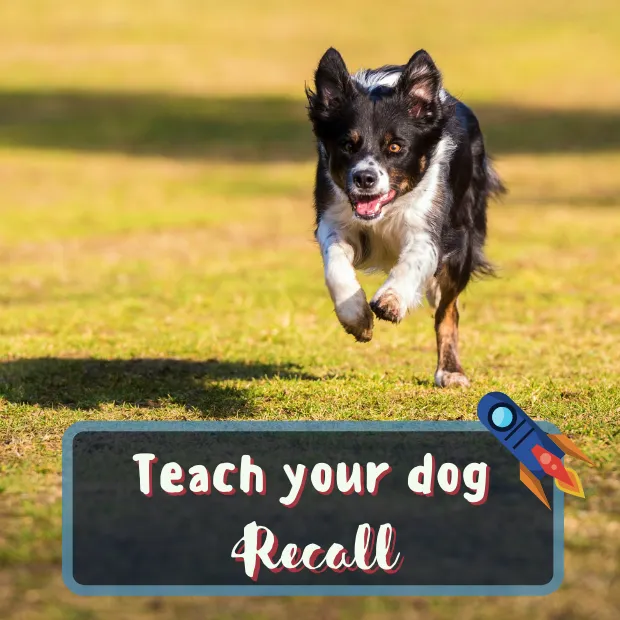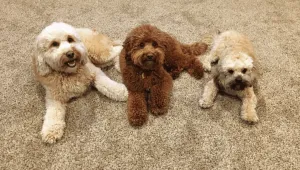If you want your dog to come back when you call them, have a read of this article on how to teach your dog recall.
Table of Contents
ToggleWhat is recall?
Recall is the name given to the behavior of getting your dog’s attention and having them come running over to you when called.
Why is recall important?
Recall is important because it allows you to keep your pup out of situations where they could get into trouble. When they are on a walk, having them come when you call will help prevent them from chasing after another dog, getting into the middle of a fight or becoming lost.
Here are some other potential problems that can occur if your pooch doesn’t have a good recall:
- Your dog escapes the house or fenced yard and you can’t get them back.
- Your dog gets too close to another dog and is attacked.
- They find something really stinky and won’t come back because of the distraction.
- You can’t get them back on leash when it’s time to leave the park.
These are just some ways that not being able to recall your furry friend can lead to problems, but there are many more!
Recall is an important part of having Fido be a happy and well-behaved member of your family and society. Having them learn proper recall is the single most important behavior in terms of safety. This is because being able to get them to come back allows you to get control of them in any situation, no matter how much fun he is having or how excited he might be.
Dogs trained to have a good emergency recall can enjoy a lot more freedom.
What’s a recall cue?
Firstly, choose your cue/command. This is a word or short phrase you will use to call your dog to come towards you.
It should be short and snappy, easy for your dog to understand, and not something they hear often in everyday life that might mean something different.
Here are some examples of what your recall command can be:
- “come!”
- “here!”
- “pup up!”
- “this way!”
Remember that your recall needs to be short and easy so your dog doesn’t get confused when you use it!
Part of recall is getting your pooch to understand that “come” or “here” means “run towards me”.
Once they know what the word “come” means, you can use it to call them away from things they want, to prevent them from getting into trouble or injuring themselves.
Why do we not just use the dog’s name for recall?
A recall word is an important tool that tells your dog exactly what you want him to do rather than just getting him to look at you, which can lead to him doing something else instead of coming to you.
It can also be dangerous to use your dog’s name because it means different things in different situations, which can be confusing for them. We use our dog’s names a lot during our daily interactions with them, and not always positively!
Our recall word needs to be a sound that our dog only has great associations with, one that we’ve never used in an angry voice and something that hasn’t become simply background noise through overuse.
We don’t want our recall word to be something the dog has already learnt to ignore.
How do I train my dog to come when called?
To teach your recall, you need to pair it with food or a favorite toy for enough instances that your dog learns when they hear this word, something good always follows. This way, your dog will get excited when they hear it because he knows he’ll be having fun after!
- The first step is adding some value to the recall word. Start adding value to the command indoors at home, by saying your dog’s recall just once, then immediately give him/her a high-value treat. The dog doesn’t have to do anything at this stage. You’re just saying the word and putting food into your dog. This is “charging it up” to give it value in the dog’s mind. This is the step most people miss, but it’s an important tactic for a reliable recall.
- At home or in the garden, have a handful of really delicious food rewards in your pocket and encourage your dog to offer eye contact from a few feet away by using his name or making kissy noises. Once he gets excited enough to start moving towards you, use his recall word with a cheerful voice. When he comes running, give him a food reward and tell him what a good boy he is. Repeat this step many repetitions throughout the day, practicing when your dog is close to you and when he’s far away from you. You want him to think that “come” is such a fun word that he’ll run over to you no matter what.
- Once your dog has learned this, it’s time for starting to train in slightly more challenging environments with distractions far enough away that he can ignore them. Call him over and as he comes running to you show him his reward. When he reaches you, give him the food and let him know you’re happy with him. You can also play a fun game such as fetch or tug to get your dog excited about coming back to you. Be careful not to do too many repetitions of this step, because it can backfire on you if you call him over and he doesn’t come running because he’s not excited anymore.
- Now your dog has mastered the recall in a low level of distraction environment, start increasing the difficulty, such as when you are standing further away or in the presence of other people. Try to call your dog over just once. When he comes running back to you, give him a titbit and tell him he’s a good boy.
- Once your dog has learned recall, start using it in more distracting environments. The more different scenarios you practice in, the better he will understand what this means when he hears it later on.
- Finally, when your dog is very good at coming back, you can start using it in real-life situations. The recall is a very useful tool for keeping your dog safe, so it’s important to practice this often even once he knows how to do it.
What NOT to do when teaching your dog recall…
Here are some additional things you might want to consider:
- Try not to use the recall for calling your dog for things he doesn’t like, such as having a bath. You don’t want your dog to have a negative association with their recall. This is known as a poisoned cue.
- Don’t have marathon sessions! Keep it short and exciting so that your dog is always looking forward to training time.
- Don’t use the word twice (double cueing), you need your dog to respond first time every time!
- Keep your dog on a longline until their recall is 19/20, so that if they don’t respond, you can easily get them back.
- If he doesn’t come, don’t stress out or become frustrated. Dogs know when their owner is mad even before we do. It will make your dog anxious and stressed out, which will make him less likely to come back in the future.
Rewards vs correction?
You should always use positive reinforcement such as verbal encouragement and treats to train your dog. Punishments like yelling at your dog or intimidating him, should be avoided because it can damage trust and cause anxiety in your pet.
It may be difficult not to yell at them for not coming back, but if you do so, he will become fearful of you and stop listening. I wouldn’t want to run to someone if I knew I was going to be told off for doing so!
What are some ways that I can make sure my dog comes back?
Start by practicing recall with very low distractions first, then progress on to more complicated situations. Use a longline so you can always get them back if they’re not listening and make sure to have regular recall practice sessions.
Using high-value morsels like cooked chicken or string cheese is very helpful because your dog will want to come back for them. Check out this post if you’re wondering what are the best dog treats for training when teaching your dog recall.
What next?
If at first you don’t succeed, go back a step and make it easier for your dog to comply. This may mean working on recall in an area with fewer distractions or having him quite close by to begin with.
It can take weeks or months of practice, but as long as you are using very high value rewards and lots of praise, you will eventually see progress. Keep practicing distance recalls often and before you know it, your dog will come running to you whenever you ask.
Good luck! Hopefully, this helped answer some of your questions.
For more help with teaching your dog recall, check out this online course by SpiritDog Training.







